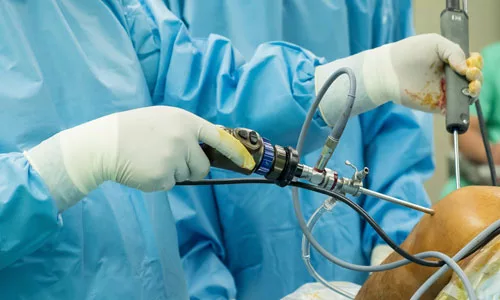 Are you interested in how arthroscopic shoulder stabilizing methods have changed in the past few years? As medical technology improves, so do the tools and techniques used to improve the results of arthroscopy shoulder surgeries. The invention of arthroscopy shoulder materials is one of the most important parts of these modifications. During surgery to fix torn or broken soft tissues, these anchors are significant for supporting and reattaching the tissues. This blog will discuss the latest materials used in orthopedic surgery and how they are changing the field. We’ll explore arthroscopy shoulder anchor materials and their potential for stability.
Are you interested in how arthroscopic shoulder stabilizing methods have changed in the past few years? As medical technology improves, so do the tools and techniques used to improve the results of arthroscopy shoulder surgeries. The invention of arthroscopy shoulder materials is one of the most important parts of these modifications. During surgery to fix torn or broken soft tissues, these anchors are significant for supporting and reattaching the tissues. This blog will discuss the latest materials used in orthopedic surgery and how they are changing the field. We’ll explore arthroscopy shoulder anchor materials and their potential for stability.
What Is An Arthroscopy Shoulder Anchor?
Arthroscopy shoulder anchor refers to a medical device used in arthroscopic shoulder surgery. Arthroscopy is a minimally invasive surgical procedure that allows orthopedic surgeons to diagnose and treat various shoulder joint problems.
During arthroscopic shoulder surgery, small incisions are made in the shoulder, and a thin tube with a camera, known as an arthroscope, is inserted to visualize the joint’s interior.
Shoulder anchors stabilize and reattach torn or damaged soft tissues, such as tendons or ligaments, to the bone. They are typically made of materials like metal or bio-composites and come in different shapes and sizes to suit specific surgical needs.
These anchors are inserted through small incisions, and once placed correctly, they provide a secure point of attachment for the repaired soft tissues, aiding in the healing process and restoring shoulder function. Arthroscopic shoulder surgery using shoulder anchors has become a widely adopted technique for treating various shoulder injuries, providing patients with less scarring, faster recovery, and improved outcomes compared to traditional open surgery.
Types of Shoulder Anchor
When doing arthroscopic shoulder surgery, surgeons can choose from a variety of shoulder anchors tailored to meet their individual needs.
Traditional Metal Anchors
Metal Anchors: These have been used for many years in arthroscopic shoulder surgeries and are usually made of titanium or stainless steel. They’re reliable, strong, and long-lasting, all qualities that contribute to their usefulness.
Bio-composite Anchors
Bio-composite anchors combine synthetic materials like polymers and resins with more organic ones like bovine bone. The slow dissolution of bio-composite anchors facilitates tissue repair while minimizing the potential for long-term problems.
All-Suture Anchors
All-Suture Anchors These anchors are entirely constructed of durable sutures rather than any solid material. They are less intrusive than traditional fixing methods and are intended to provide a stable fixation by spreading the weight out across a larger surface area.
Absorbable vs. Non-Absorbable Anchors
Absorbable anchors and non-absorbable anchors are two types of medical devices used in orthopedic surgery, particularly in procedures like arthroscopic shoulder surgery. The main difference between the two lies in their material composition and how they interact with the body post-surgery. 
Emerging Materials and Innovations
Emerging materials and innovation in the field of arthroscopy shoulder anchor materials form a cutting-edge frontier that is altering the field of orthopedic surgery.
Shoulder anchors are utilized in arthroscopic shoulder surgeries, and researchers and medical professionals are always looking for innovative ways to improve their efficiency and durability.
In order to enhance surgical methods, decrease patient suffering, and maximize the success of shoulder stabilization treatments, the medical community is continually exploring new materials and advances in arthroscopic shoulder anchor technology.
As these developments improve, patients should anticipate more refined and personalized treatments for their orthopedic demands, ultimately enhancing the entire experience and outcomes of arthroscopic shoulder surgery.
Clinical Evidence and Outcomes
Clinical evidence and outcomes are essential for assessing the effectiveness and safety of arthroscopy shoulder anchor materials and stabilization procedures. Medical research and clinical trials provide crucial data on shoulder anchor materials and patient outcomes.
The integration of clinical evidence and outcomes into medical decision-making ensures that orthopedic surgeons can make well-informed choices when selecting the most appropriate shoulder anchor materials for each patient’s unique case.
This evidence-based approach ultimately leads to better patient care, improved surgical results, and enhanced long-term success in arthroscopic shoulder stabilization procedures.
Surgeon’s Perspective
The utilization of arthroscopy shoulder anchor materials is of great value in guaranteeing favorable surgical results and patient satisfaction, as seen by orthopedic surgeons. Surgeons use their considerable skill and experience to reflect a number of requirements, helping them to make informed decisions regarding the selection of shoulder anchors tailored to the unique needs of each patient.
The precise positioning and secure connection of shoulder anchors during arthroscopic operations are of the highest priority and rely heavily on the surgical technique performed by the surgeon.
The durability of the restored tissues and the surgical procedure’s overall success are strongly impacted by their careful approach.
Conclusion
Orthopedic surgery, especially arthroscopic shoulder treatments, has changed a lot because of how quickly the materials have changed. Surgeons now have a wide range of shoulder anchors to select from. As technology continues to evolve, patients can expect even more refined and tailored solutions for their orthopedic needs, further enhancing the success and satisfaction of arthroscopic shoulder surgeries.

